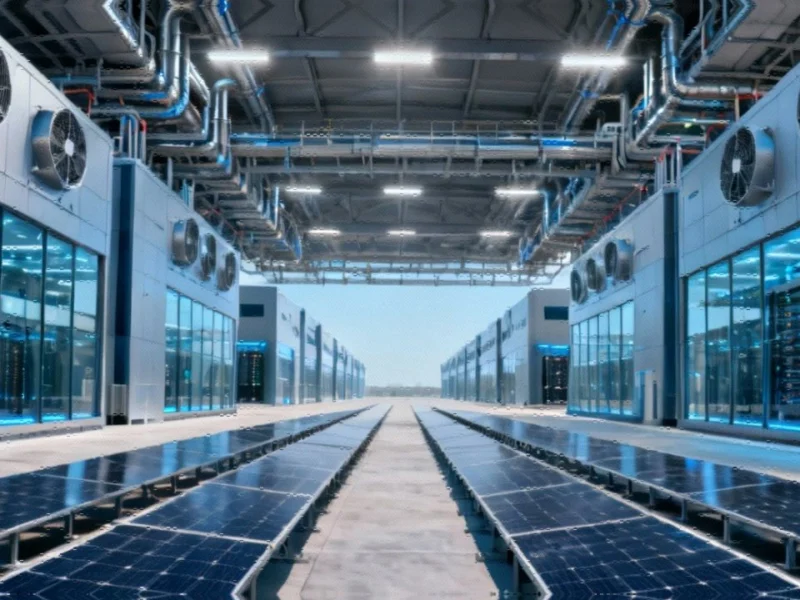Note: Featured image is for illustrative purposes only and does not represent any specific product, service, or entity mentioned in this article.
The New AI Arms Race: From Chips to Concrete
In a landmark transaction that signals the maturation of artificial intelligence infrastructure, a consortium led by BlackRock’s Global Infrastructure Partners has agreed to acquire Aligned Data Centers from Macquarie Asset Management in a deal valued at $40 billion. The investor group includes Microsoft, Nvidia, and the Artificial Intelligence Infrastructure Partnership (AIP), representing a strategic alignment of financial and technological giants betting on AI’s physical requirements.
This acquisition follows BlackRock’s growing portfolio of infrastructure investments and marks one of the largest private transactions in data center history. The deal, expected to close in the first half of 2026 pending regulatory approvals, demonstrates how capital is rapidly shifting from pure software plays to the physical infrastructure required to power next-generation AI applications.
From Two Facilities to Global Footprint
Under Macquarie’s seven-year stewardship, Aligned has transformed from a modest operation with two locations into a global powerhouse spanning 50 data center campuses across five countries. The company now boasts more than 5 gigawatts of operational and planned capacity across the United States, Mexico, Brazil, Chile, and Colombia.
“The scaling of Aligned Data Centers from two locations to 50 in seven years is representative of our approach to working with great companies and teams to support their rapid growth and deliver positive impact,” said Ben Way, head of Macquarie Asset Management, in a statement announcing the deal.
This explosive growth trajectory reflects the broader transformation of power infrastructure to meet unprecedented computational demands. As AI models grow exponentially in size and complexity, the physical requirements for housing and powering them have become a critical bottleneck in the technology ecosystem.
The Infrastructure Investment Thesis
The financial logic behind this massive acquisition points toward the long-term monetization of physical AI infrastructure assets. According to Reuters, the consortium plans to deploy up to $30 billion in equity, with the capacity to expand to $100 billion including debt financing.
This investment represents a fundamental shift from speculative AI software investments toward tangible assets that determine real computational capacity. The move echoes similar major infrastructure bets happening across the energy and technology sectors, where private capital is flowing into foundational technologies that will support decades of digital transformation.
Microsoft and Nvidia’s participation is particularly significant, marking a strategic evolution from infrastructure customers to infrastructure owners. By joining the consortium, both companies are securing their supply chains for the computational resources their AI ambitions require.
The Power Imperative
Data centers have become the industrial plants of the digital age, consuming energy at rates comparable to small cities. Oracle’s recent revelation of its 1,000-acre data center campus in Abilene, Texas – described by Co-founder and CTO Larry Ellison as a “1.2-billion-watt AI brain” – illustrates the scale required for competitive AI infrastructure.
These developments highlight how grid modernization efforts have become inextricably linked to technological advancement. The AI infrastructure race is increasingly dependent on reliable, high-capacity power delivery systems that can support the massive energy demands of computational clusters.
Oracle’s campus, which hosts more than 450,000 Nvidia GB200 GPUs, represents the new benchmark for industrial-scale AI compute facilities. The Aligned acquisition positions the BlackRock consortium to compete at this scale across multiple geographic markets.
Strategic Implications for Industrial Technology
This transaction underscores several critical trends shaping the future of industrial technology and manufacturing:
- Vertical Integration: Technology companies are moving upstream to secure their infrastructure supply chains
- Power as Currency: Access to reliable, scalable energy has become a competitive advantage
- Geographic Diversification: AI infrastructure requires global distribution to serve international markets efficiently
- Industrial Scale Computing: Computational resources are becoming centralized in facilities that rival traditional industrial plants in scale and complexity
The evolution of platform strategies now extends beyond software ecosystems to include physical infrastructure ownership. This represents a fundamental shift in how technology companies approach competitive moats and supply chain security.
The Future of AI Deployment
As AI capabilities continue to advance, the infrastructure required to support these technologies is becoming increasingly specialized. The Aligned acquisition signals a maturation of the AI market, where computational resources are being treated as strategic assets rather than commoditized services.
This aligns with broader advancements in AI applications across education, research, and industrial sectors. The availability of reliable, high-performance computing infrastructure will determine the pace of innovation in these domains.
Meanwhile, security considerations remain paramount as critical infrastructure becomes increasingly interconnected and essential to economic activity. The concentration of computational resources in massive data center campuses creates both efficiencies and potential vulnerabilities that must be managed carefully.
The Aligned transaction represents a watershed moment in the industrialization of artificial intelligence. As capital consolidates around the physical assets that power AI, the companies controlling these resources will increasingly shape the direction and pace of technological progress across every sector of the global economy.
This article aggregates information from publicly available sources. All trademarks and copyrights belong to their respective owners.



